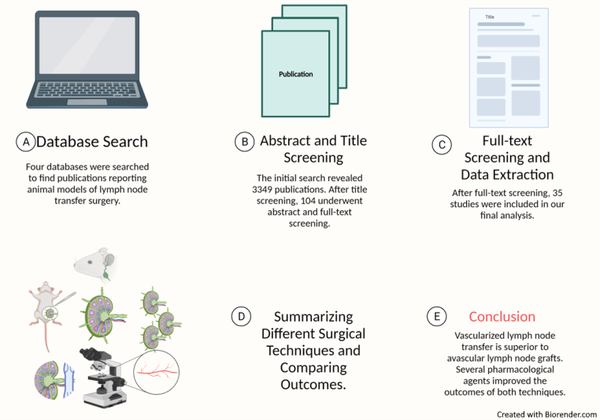-
Home
-
About JCTR
-
Gold Open Access
-
Issues
-
Editorial board
-
Author guidelines
-
Publication fees
-
Online first
-
Special issues
-
News
-
Publication ethics
-
Partners
-
Submit your manuscript
-
Submit your review report
-
Editorial Office
-

This work is licensed under a Creative Commons Attribution-NonCommercial 4.0 International License. ISSN print: 2382-6533 ISSN online: 2424-810X
Volume 8 Issue 3
Animal models in lymph node transfer surgery: A systematic review
Abdullah S. Eldaly, Francisco R. Avila, Ricardo A. Torres-Guzman, Karla C. Maita, John P. Garcia, Luiza P. Serrano, Humza Y. Saleem, Antonio J. Forte*
Eldaly et al. J Clin Transl Res 2022; 8(3):3
Published online: May 25, 2022
Abstract
Background and aim: Lymph node transfer surgery (LNTS) is indicated in secondary lymphedema patients who do not respond to conservative therapy. Animal models are the spearhead of lymphedema research and were used to pioneer most of the surgical interventions currently in practice. We conducted a systematic review of the literature to explore animal models dedicated to lymph node transfer surgery to compare different species, techniques, and outcomes.
Methods: Four databases were searched: PubMed, Cumulative Index of Nursing and Allied Health Literature (CINAHL), Scopus, and Web of Science. We used the Preferred Reporting Items for Systematic Reviews and Meta-Analysis as our basis of organization.
Results: Avascular lymph node graft (ALNG) and vascularized lymph node transfer (VLNT) effectively treated lymphedema and lead to better outcomes than controls. Whole ALNGs are superior to fragmented ALNGs. Larger fragments are more likely to be reintegrated into the lymphatic system than small fragments. VLNT was superior to whole and fragmented ALNG. Increasing the number of VLNT resulted in better outcomes. Adipose-derived stem cells improved outcomes of VLNT; vascular endothelial growth factor C and D, and platelet rich plasma improved outcomes for ALNG. Cryopreservation of lymph nodes did not affect outcomes for ALNG. The critical ischemia and venous occlusion time for LN flaps were 4-5 and 4 hours, respectively. The critical time for reperfusion injury was 2 hours. Some of the novel models included venous LNT, and cervical adipo-cutaneous flap to groin.
Conclusion: Current evidence from animals favors VLNT over other surgical interventions. Several pharmacological therapies significantly improved outcomes of ALNG and VLNT.
Relevance to patients: Lymphedema is a chronic condition affecting millions of patients worldwide. Lymph node transfer surgery is becoming more popular as a lymphedema treatment. Animal models have led the lymphedema research for decades and developing new models for lymphedema is essential for lymphedema research. This systematic review aims to summarize the existing animal models dedicated to lymph node transfer surgery. We believe this review is critical to guide researchers in the selection of the model that is best fit for their hypothesis-driven experiments.

DOI: http://dx.doi.org/10.18053/jctres.08.202203.003
Author affiliation
1. Division of Plastic Surgery, Mayo Clinic, Jacksonville, Florida, USA.
2. Department of General Surgery, Mayo Clinic, Jacksonville, Florida, USA.
*Corresponding author
Antonio J. Forte
Mayo Clinic Florida, 4500 San Pablo Rd, Jacksonville, FL 32224
Tel: 904-953-2073,
Email: ajvforte@yahoo.com.br
Handling editor:
Michal Heger
Department of Pharmaceutics, Utrecht University, the Netherlands
Department of Pharmaceutics, Jiaxing University Medical College, Zhejiang, China

